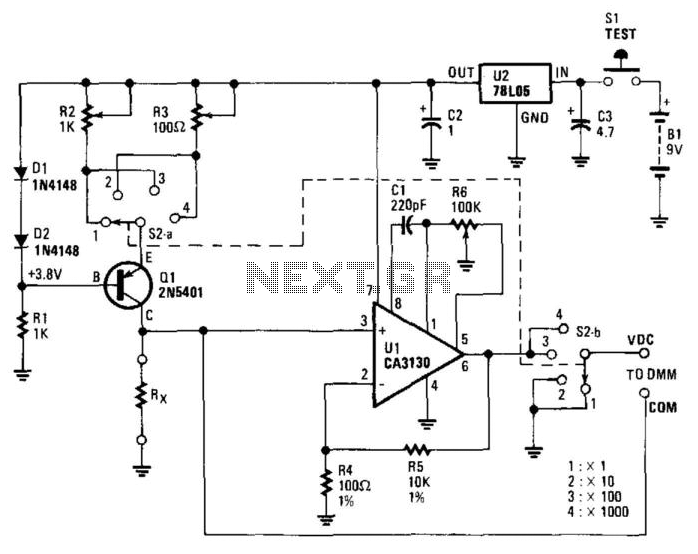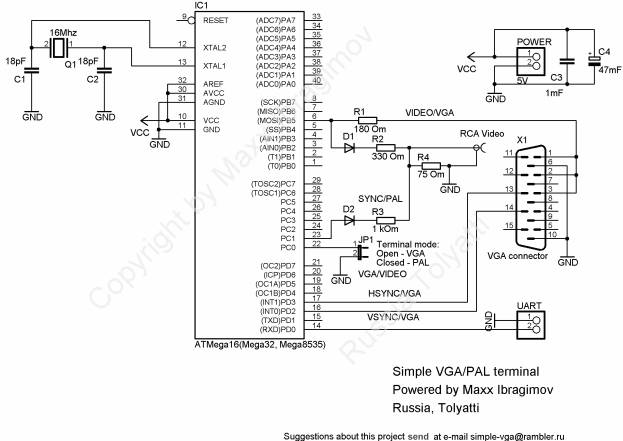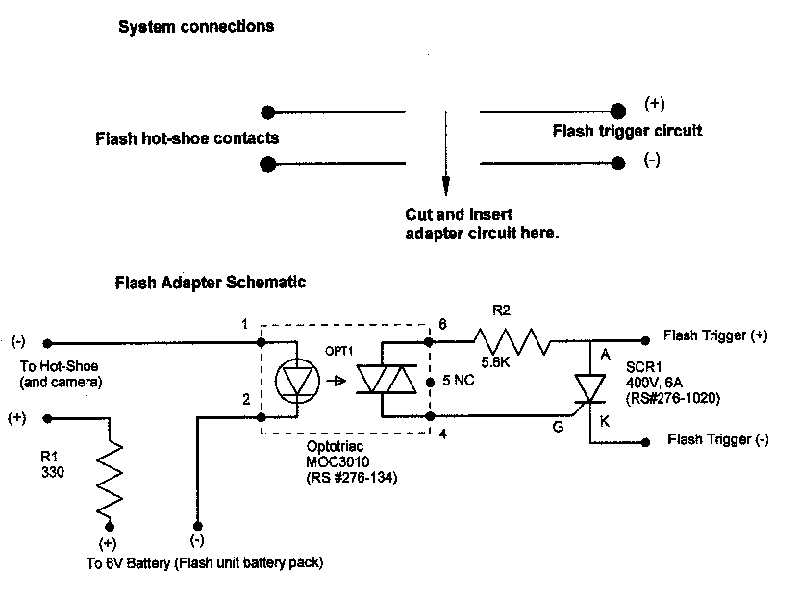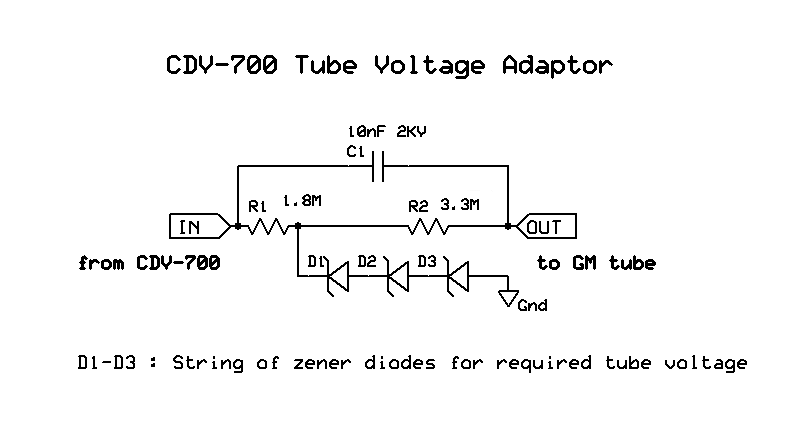
Low-Ohms Adapter

The circuit includes a 5-V regulator, a constant-current source (D1, D2, and Q1), and an operational amplifier (op amp) gain stage (U1). Power is supplied by a 9-V battery, which is regulated to +5 V DC by a three-terminal regulator. The emitter of Q1 is consistently 0.6 V below the +5-V line. Resistor R1 establishes a current of 5 mA through both diodes D1 and D2. The resulting 0.6 V DC across one of the multiturn trimmer potentiometers (R2 and R3), selected by switch section S2A, determines the current through Q1 and the resistor under test. When R2 is selected, the test current is 1 mA; when R3 is selected, the test current is 10 mA. In the lower two ranges (1 mA and 10 mA), the voltage across the resistor under test is applied directly to the digital multimeter (DMM) terminals. In the upper two ranges, the op amp gain stage U1 is integrated into the circuit, and the DMM measures the voltage between the op amp output pin 6 and the test resistor. When switch S2 is in position 3 (x 100), the current set by the constant-current source is 1 mA, yielding a multiplying factor of 100. When S2 is in position 4 (1000), the current is 10 mA, resulting in a multiplying factor of 1000. Multiturn trimmer potentiometer R6 adjusts the offset of the op amp, ensuring that with no voltage across the resistor under test (i.e., when the measurement terminals are short-circuited), the output reads zero.
The circuit is designed for precise measurement and testing of resistive components by utilizing a regulated power supply and a constant current source. The 5-V regulator ensures stable operation of the circuit, while the constant current source, facilitated by the diodes D1 and D2 and transistor Q1, maintains a consistent test current, which is critical for accurate resistance measurements.
The operational amplifier (U1) acts as a gain stage, amplifying the voltage drop across the resistor under test when higher ranges are selected. This amplification is essential for measuring low-resistance values accurately, as it increases the sensitivity of the measurement. The switch S2A allows the user to select between different test currents and ranges, providing versatility for testing various resistor values.
The multiturn trimmer potentiometers R2 and R3 allow for fine adjustment of the test current, ensuring that the circuit can accommodate a wide range of resistances without exceeding the limits of the DMM. The adjustment of R6 is crucial for calibrating the op amp, ensuring that any offset is corrected, and that the output accurately reflects the voltage across the resistor under test.
Overall, this circuit is an efficient and effective solution for testing and measuring resistances, providing both flexibility and precision in electronic applications. The circuit consists of a 5-V regulator, constant-current source Dl, D2, and Ql, and op amp gain stage Ul. Power is provid ed by a 9-V battery whose output is regulated to +5 Vdc by the 3-terminal regulator. The emitter of Ql is always 0.6 V below the +5-V line. Resistor R1 sets the current through both diodes Dl and D2 to 5 mA. The resulting 0.6 Vdc across one of the multiturn trimmer potentiometers (R2 and R3), as selected by switch section S2A, sets the current through Ql and the resistor-under-test. When R2 is selected, the test current is 1 mA; when R3 is selected, the test current is 10 mA. On the lower two ranges, 1 and 10, the voltage across resistance-under-test is applied directly to the DMM terminals.
On the upper two ranges, op amp gain stage Ul is switched into the circuit and the DMM measures the voltage between op amp output pin 6 and the test resistor. When switch S2 is in position 3 (x 100) the current set by the constant-current source is 1 mA; the multiplying factor is 100.
When S2 is in position 4, 1000, the current is 10 mA and the multiplying factor is 100 10 = 1000. Multiturn trimmer-potentiometer R6 adjusts the offset of the op amp so that, with no voltage across the resistor-under-test (i.e., with the measurement terminals short-circuited), the output is zero.
The circuit is designed for precise measurement and testing of resistive components by utilizing a regulated power supply and a constant current source. The 5-V regulator ensures stable operation of the circuit, while the constant current source, facilitated by the diodes D1 and D2 and transistor Q1, maintains a consistent test current, which is critical for accurate resistance measurements.
The operational amplifier (U1) acts as a gain stage, amplifying the voltage drop across the resistor under test when higher ranges are selected. This amplification is essential for measuring low-resistance values accurately, as it increases the sensitivity of the measurement. The switch S2A allows the user to select between different test currents and ranges, providing versatility for testing various resistor values.
The multiturn trimmer potentiometers R2 and R3 allow for fine adjustment of the test current, ensuring that the circuit can accommodate a wide range of resistances without exceeding the limits of the DMM. The adjustment of R6 is crucial for calibrating the op amp, ensuring that any offset is corrected, and that the output accurately reflects the voltage across the resistor under test.
Overall, this circuit is an efficient and effective solution for testing and measuring resistances, providing both flexibility and precision in electronic applications. The circuit consists of a 5-V regulator, constant-current source Dl, D2, and Ql, and op amp gain stage Ul. Power is provid ed by a 9-V battery whose output is regulated to +5 Vdc by the 3-terminal regulator. The emitter of Ql is always 0.6 V below the +5-V line. Resistor R1 sets the current through both diodes Dl and D2 to 5 mA. The resulting 0.6 Vdc across one of the multiturn trimmer potentiometers (R2 and R3), as selected by switch section S2A, sets the current through Ql and the resistor-under-test. When R2 is selected, the test current is 1 mA; when R3 is selected, the test current is 10 mA. On the lower two ranges, 1 and 10, the voltage across resistance-under-test is applied directly to the DMM terminals.
On the upper two ranges, op amp gain stage Ul is switched into the circuit and the DMM measures the voltage between op amp output pin 6 and the test resistor. When switch S2 is in position 3 (x 100) the current set by the constant-current source is 1 mA; the multiplying factor is 100.
When S2 is in position 4, 1000, the current is 10 mA and the multiplying factor is 100 10 = 1000. Multiturn trimmer-potentiometer R6 adjusts the offset of the op amp so that, with no voltage across the resistor-under-test (i.e., with the measurement terminals short-circuited), the output is zero.





